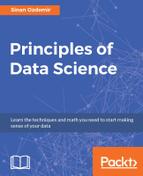Sometimes, we need to deal with two or more events. These are called compound events. A compound event is any event that combines two or more simple events. When this happens, we need some special notation.
Given events A and B:
- The probability that A and B occur is P(A ∩ B) = P(A and B)
-
The probability that either A or B occurs is P(A
 B) = P(A or B)
B) = P(A or B)
Understanding why we use set notation for these compound events is very important. Remember how we represented events in a universe using circles earlier? Let's say that our Universe is 100 people who showed up for an experiment, in which a new test for cancer is being developed:

In the preceding diagram, the red circle, A, represents 25 people who actually have cancer. Using the relative frequency approach, we can say that P(A) = number of people with cancer/number of people in study, that is, 25/100 = ¼ = .25. This means that there is a 25% chance that someone has cancer.
Let's introduce a second event, called B, as shown, which contains people for whom the test was positive (it claimed that they had cancer). Let's say that this is for 30 people. So, P(B) = 30/100 = 3/10 = .3. This means that there is a 30% chance that the test said positive for any given person:

These are two separate events, but they interact with each other. Namely, they might intersect or have people in common, as shown here:

Anyone in the space that both A and B occupy, otherwise known as A intersect B or A ∩ B, are people for whom the test claimed they were positive for cancer (A) and they actually do have cancer. Let's say that's 20 people. The test said positive for 20 people, that is, they have cancer, as shown here:

This means that P(A and B) = 20/100 = 1/5 = .2 = 20%.
If we want to say that someone has cancer or the test came back positive. This would be the total sum (or union) of the two events, namely, the sum of 5, 20, and 10, which is 35. So, 35/100 people either have cancer or had a positive test outcome. That means, P(A or B) = 35/100 = .35 = 35%.
All in all, we have people in the following four different classes:
- Pink: This refers to the people who have cancer and had a negative test outcome
- Purple (A intersect B): These people have cancer and had a positive test outcome
- Blue: This refers to the people with no cancer and a positive test outcome
- White: This refers to the people with no cancer and a negative test outcome
So, effectively, the only times the test was accurate was in the white and purple regions. In the blue and pink regions, the test was incorrect.
